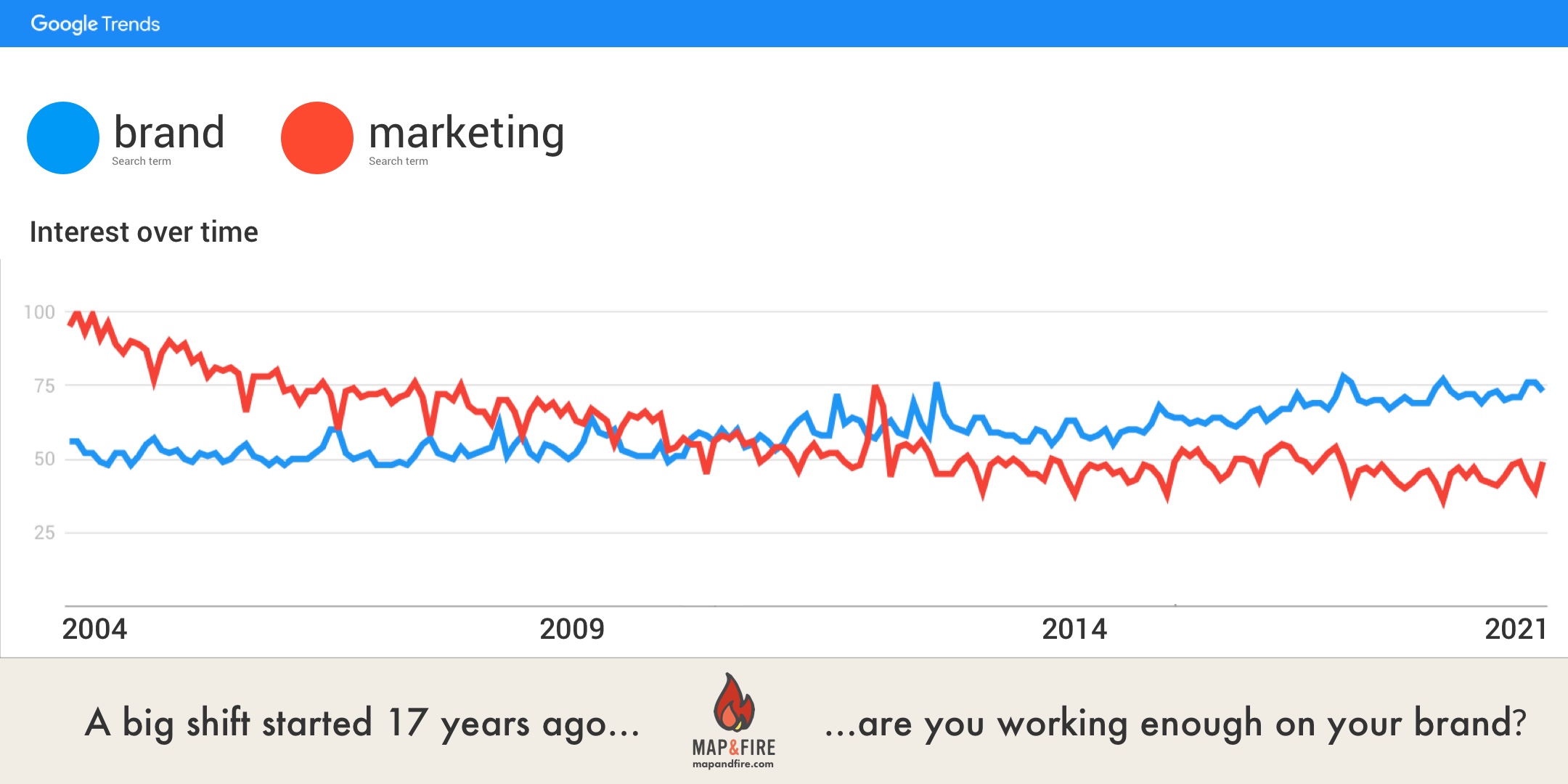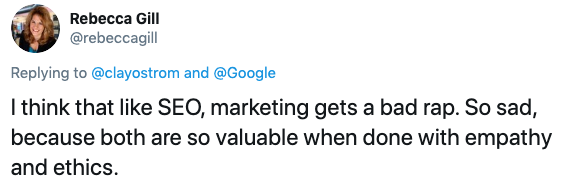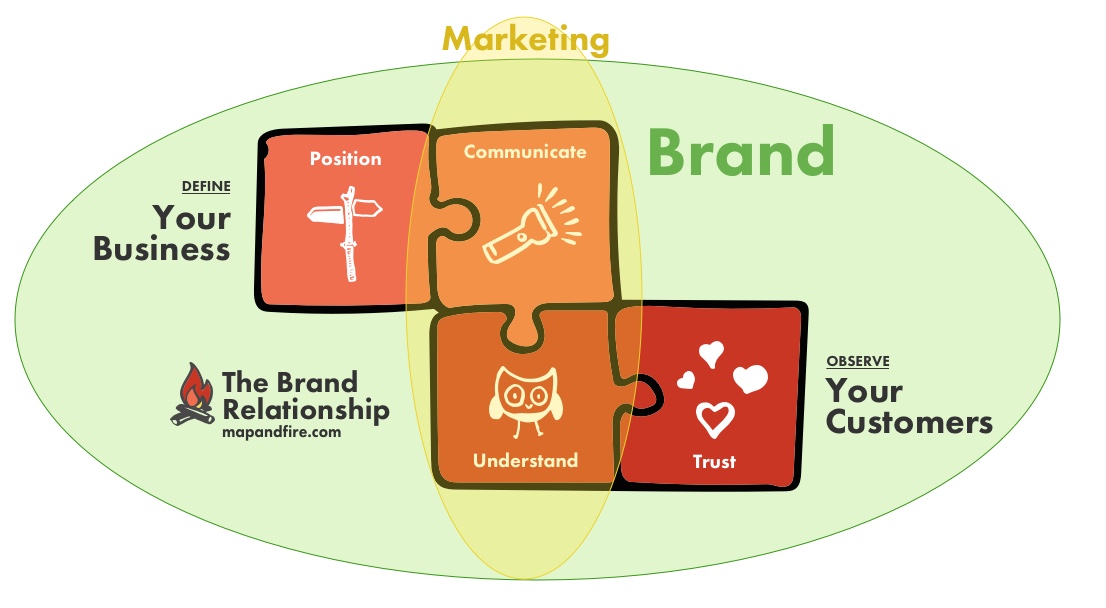
The words we search for on Google can provide an excellent peek into how we think about concepts. And when it comes to the growth and success of businesses, two words that get a lot of attention are “brand” and “marketing”.
Which of these words do we use more in our collective searches? And what does their relative popularity say about the way we think about businesses?
The Google Trends chart for those two terms between 2004 (the earliest point for Google’s data) and 2021 reveals a very clear and interesting shift.
Where searches related to “marketing” dominated “brand” 17 years ago, the inverse is now true in 2021.
There are lots of ways to interpret this data of course. To start, the term “brand” has become a bigger part of the modern zeitgeist.
Discussion around brands has grown well beyond the Nikes, Cokes, and Apples of the world. Everyone from athletes to reality TV stars build and promote their own brands.
In the professional world, where the average job stay has shrunk from 10 years to about 3, people now build personal brands to help tell a cohesive story about their skills and experience.
But while those uses contribute to the term “brand” popping up more, it doesn’t totally address why it’s favored.
Do the increased searches for brand reflect the idea that we expect companies to build relationships with-us, versus simply marketing at-us?
First, What Happened To Marketing?
Customers don’t necessarily dislike marketing, they dislike aggressive and abusive marketing. And the digital age has spawned a whole new set of tactics that aggravate customers.
Product sites block your path with promo popups. Social and content sites jam every available pixel with display ads and “related content” designed to pull your focus. And tracking and targeting are now standard across every industry.
It’s easy to see why this erodes the sentiment around marketing.
In a study done by Hubspot, 91% of respondents said ads are more intrusive today compared to 2-3 years ago. 79% felt they were being tracked by retargeted ads.
In the same study, 83% of respondents said that ads aren’t bad, they just want the ability to filter out the obnoxious ones.
Here’s what marketing expert Rebecca Gill had to say about this topic on Twitter:

This crystallizes a key takeaway.
When businesses employ marketing with empathy and solid ethics, it shifts from an annoyance to a valuable point of connection for customers.
That’s where the influence of brand comes into play.
Strong Brands Build Healthy Relationships With Customers
The comparison of the terms “marketing” and “brand” isn’t meant to imply that they’re at odds with one another. Marketing is a critical part of every brand.
The shift in their search use may speak more to the evolution of relationships between customers and businesses.
Rather than customers looking at businesses through the narrow lens of marketing, a focus on brand pulls back to show a more complete view.
This was our focus in developing The Brand Relationship model:
For the business:
- How does the business itself operate?
- What’s the vision and mission of the business and what values does it uphold?
- What unique position does the business occupy to satisfy their customers’ needs?
For the customers:
- What’s the collective value that customers receive from the business in exchange for their attention and dollars?
- Why should customers trust that the business will deliver that value consistently and with integrity over time?
A brand speaks to all these elements. It conveys how these elements work in concert to provide alignment in that relationship.
Businesses with strong brands develop healthier exchanges of value with their customers. In marketing terms, it’s about looking beyond the cost of acquisition and focusing on a customer’s lifetime value.
In other words, is the business looking for a quick hit? Or are they in it for the long haul?
Treat The Customer Relationship With Care
The relationships between customers and businesses keep getting more and more sophisticated. We have more access than ever to information about how businesses operate. We care about how their leaders and teams behave and what goes into the products and services they deliver.
And of course we care about the way those businesses communicate and engage with us in their marketing.
All of that information feeds into our perception of their brand. It impacts our decisions on who we engage with and where we spend our money.
As customers get more savvy and businesses react to their needs, it makes sense that our collective use of “brand” will continue to increase.
The question then is how well your business defines and expresses its brand to keep up with the ever-evolving expectations of your customers.

Get Help Connecting With Your Customers
If you’re ready to build stronger connections with your customers, reach out for a free consultation. We’ll help you transform your best business thinking into an actionable, shareable, growth-oriented guide. Click below to learn more about the Brand Guidebook process.


